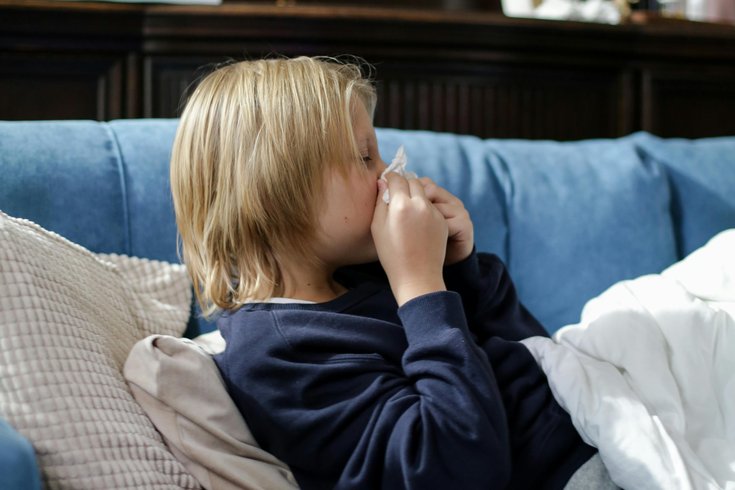
October 21, 2024
 cottonbro studio/Pexels
cottonbro studio/Pexels
Bacterial infections from Mycoplasma pneumoniae, which can cause walking pneumonia, have surged since late spring, according to the CDC. The spike has been highest in children ages 2-4.
Cases of "walking pneumonia" — a milder form of the lung infection pneumonia — have spiked in the United States, particularly among young children.
Bacterial infections from Mycoplasma pneumoniae, one of the causes of walking pneumonia, have increased among all age groups in the U.S. since late spring, according to hospital discharge data released by the Centers for Disease Control and Prevention. The spike was highest in children ages 2-4, rising from 1% discharges on March 31 to 7.2% on Oct. 5, the CDC said.
MORE: Whooping cough cases are on the rise – particularly in Pennsylvania
M. pneumoniae can damage the lining of the respiratory tract, including the throat, windpipe and lungs. Infections are generally mild, with symptoms similar to a chest cold. But they can progress to pneumonia – a lung infection that causes swollen airways and mucus to build up in the lungs.
When M. pneumoniae infections cause pneumonia, it usually is the less severe form known as walking pneumonia, which does not cause people to stay in bed or at home. But the spike in M. pneumonaiae infections was enough for the CDC to alert the public.
"The increase in children ages 2–4 years is notable because M. pneumoniae historically hasn't been recognized as a leading cause of pneumonia in this age group," CDC officials wrote in a news release.
In previous years, most infections were observed among school-aged kids and adolescents, according to the CDC.
There are an estimated 2 million bacterial infections caused by M. pneumoniae each year in the U.S., the CDC said. Last year, M. pneumoniae began to re-emerge globally following a period of low infections dating back to the start of the COVID-19 pandemic. The infections usually occur more often in summer and early fall. This year, infections peaked in August and have remained high since.
Here's how to prevent walking pneumonia, and information on its symptoms and treatment options from the CDC and Cleveland Clinic:
Symptoms may include sore throat, fatigue, chest pain, a low-grade fever (less than 101 degrees), mild chills, coughing, sneezing and a headache. Younger children may have different symptoms, including diarrhea, wheezing or vomiting, according to the CDC.
Walking pneumonia is very contagious and can be spread through airborne droplets. People who are infected are contagious for two-to-four weeks before symptoms appear. They remain contagious until their symptoms go away. Walking pneumonia can last four to six weeks, and the cough is usually the longest-lasting symptom.
If symptoms like wheezing or breathing difficulties are persistent or worsen, medical attention should be sought – particularly for people who are at higher risk of developing severe infections. People at higher risk include those with asthma or reactive airway disease.
Pneumonia has several causes, including bacterial, viral and fungi infections.
To diagnose walking pneumonia, health care providers will perform a physical examination that includes listening to the lungs. Tests will be ordered to confirm the diagnosis.
Walking pneumonia tests usually occur in emergency departments and other hospital settings, but they also may be done in outpatient clinics. These tests include nose and throat swabs, blood samples and chest X-rays.
Treatment depends on the cause of the infection. If it's caused by bacteria, doctors may prescribe antibiotics. Most people can recover on their own, using over-the-counter medicines to assuage symptoms. If it's caused by a virus or fungus, the illness must run its course.
Walking pneumonia is typically too mild to require hospitalization, but serious complications such as asthma, severe pneumonia and encephalitis (brain disease) may occur.
Walking pneumonia is more likely among people who are 2 or younger, 65 or older, have weakened immune systems, use tobacco products, live or work in crowded places, regularly inhale corticosteroids and have asthma, emphysema or chronic obstructive pulmonary disease.
There is no vaccine that prevents walking pneumonia, and it is possible to get the infection more than once. Outbreaks usually happen in crowded environments like schools, college residence halls and nursing homes.
To prevent the spread of M. pneumoniae bacteria, experts advise people to wash their hands frequently and cover their coughs and sneezes.
Getting an annual flu shot helps prevent influenza, which can cause pneumonia.
People with respiratory conditions and other chronic medical conditions should wear a mask when they are around sick people, because the risk of a severe infection is higher. They also should avoid smoking or being around people who are smoking, because the smoke can make symptoms worse.
Follow Franki & PhillyVoice on Twitter: @wordsbyfranki
| @thePhillyVoice
Like us on Facebook: PhillyVoice
Have a news tip? Let us know.